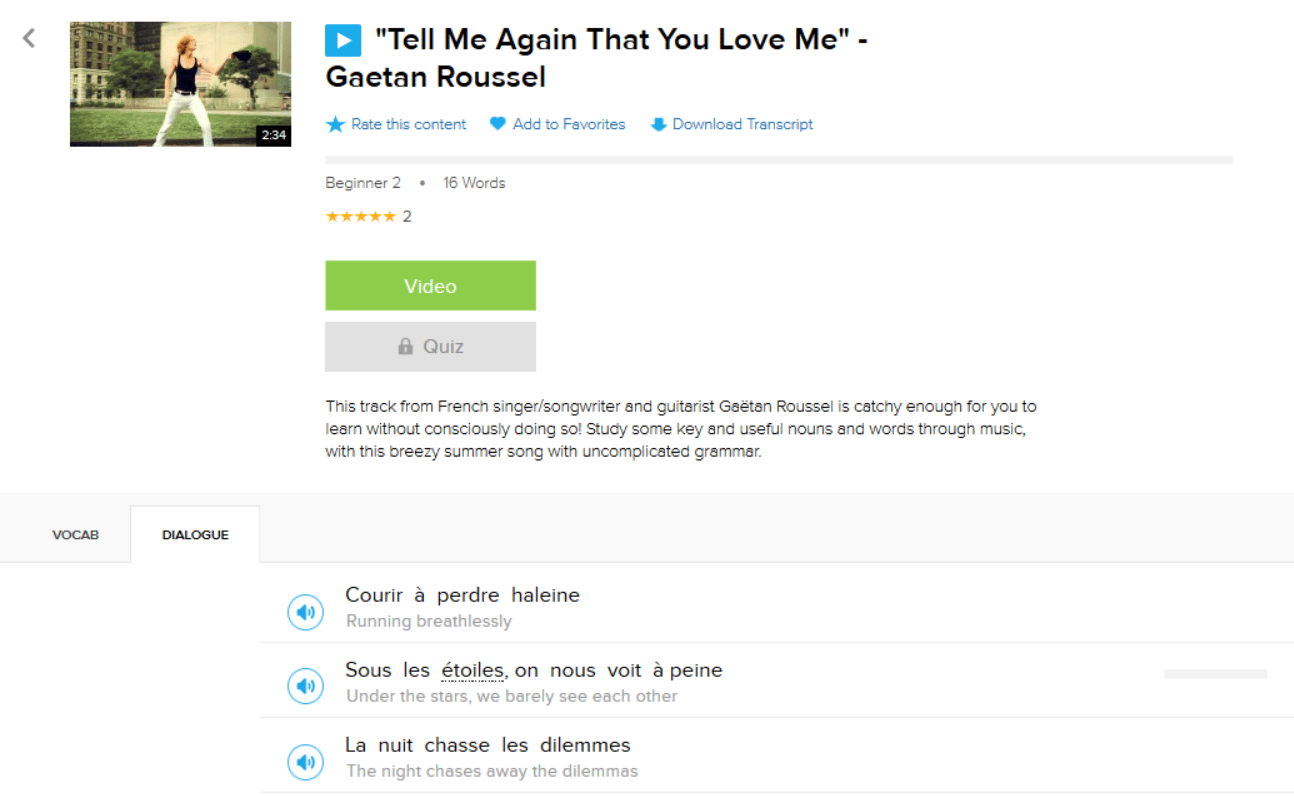Contents
- Adverbs of time
- Adverbs of manner
- Adverbs of place
- Adverbs of quantity
- Adverbs of frequency
- Adverbs of affirmation
- Adverbs of negation
- Adverbs of doubt
- Adverbs of question and exclamation
- Relative and comparative adverbs
- How to Form French Adverbs
- French Adverb Placement
- One French Adverb Mishap to Avoid: Bon vs. Bien
- And one more thing...
110 French Adverbs and How to Use Them

Adverbs are words that describe verbs or adjectives.
For example, in the sentence: “Jacque ran quickly through a very big library,” both “very” and “quickly” are adverbs.
Adverbs help you be more clear in your sentences, helping imbue your French with expressiveness and nuance.
In this post you’ll learn 110 common French adverbs you can start using right away, along with how to form French adverbs and where to place them in sentences.
Download: This blog post is available as a convenient and portable PDF that you can take anywhere. Click here to get a copy. (Download)
Adverbs of time
An adverb of time clarifies when a specific action is taking place. An adverb of time generally answers the question quand (when) in French sentences. Check out some examples below.
| French | English |
|---|---|
| Aujourd'hui | Today |
| Bientôt | Soon |
| Déjà | Already |
| Demain | Tomorrow |
| Désormais | From now on |
| Enfin | Finally |
| Hier | Yesterday |
| Immédiatement | Immediately |
| Longtemps | For a long time |
| Maintenant | Now |
| Récemment | Recently |
| Soudainement | Suddenly |
| Tard | Late, later |
| Tôt | Early |
Adverbs of manner
An adverb of manner tells us the manner in which or how something occurs. This adverb answers the question comment (how) in French. Let’s check out some adverbs of manner.
| French | English |
|---|---|
| Ainsi | Like this |
| Bravement | Bravely |
| Ensemble | Together |
| Heureusement | Fortunately |
| Lentement | Slowly |
| Malheureusement | Unfortunately |
| Précisément | Precisely |
| Professionnellement | Professionally |
| Prudemment | Carefully |
| Rapidement | Quickly |
| Suffisamment | Sufficiently |
| Vite | Quickly |
| Vraiment | Truly |
Adverbs of place
An adverb of place describes the location where an action occurs. It answers the question of où (where) in French. Take a look at the most common adverbs of place.
| French | English |
|---|---|
| Ailleurs | Elsewhere |
| Dedans | Inside |
| Dehors | Outside |
| Derrière | Behind |
| Devant | In front of |
| En bas | Below |
| En haut | High |
| Ici | Here |
| Là | There |
| Loin | Far |
| N'importe où | Anywhere |
| Partout | Everywhere |
| Près | Close |
Adverbs of quantity
The adverbs of quantity in French let us know how much or how many of something there is. These adverbs answer the question combien (how much/how many) in French.
Not that these adverbs can come before nouns. In this case, they often take the word de (of) without their definite article.
| French | English |
|---|---|
| Assez | Quite, fairly |
| Autant | As much, as many |
| Beaucoup | A lot |
| Complètement | Completely |
| Davantage | More |
| Environ | Approximately |
| Moins | Less |
| Peu | A little |
| Plus | More |
| Seulement | Only |
| Tant | So much, so many |
| Tellement | So |
| Très | Very |
| Trop | Too much |
Adverbs of frequency
An adverb of frequency lets us know how often an action occurs. Unlike adverbs of time, these don’t necessarily focus on a specific time. Rather, they focus on a time cycle where an action happens repeatedly.
| French | English |
|---|---|
| D'habitude | Usually |
| Encore | Again |
| Fréquemment | Frequently |
| Habituellement | Usually |
| Occasionnellement | Occasionally |
| Parfois | Sometimes |
| Quelquefois | Sometimes |
| Rarement | Rarely |
| Souvent | Often |
| Toujours | Always |
Adverbs of affirmation
An adverb of affirmation adds credibility to an action. They’re used to back something up or affirm that something is true or correct. Let’s dive into the most common adverbs of affirmation.
| French | English |
|---|---|
| Apparemment | Apparently |
| Assurément | Definitely |
| Certainement | Certainly |
| Certes | Certainly |
| Effectivement | Indeed, actually |
| Évidemment | Evidently |
| Immanquablement | Inevitably |
| Sans doute | Without a doubt |
| Sûrement | Surely |
| Vraisemblablement | In all likelihood |
Adverbs of negation
An adverb of negation adds an element of the negative to an action. In fact, these adverbs are the most common way to make an entire sentence negative, and many of these adverbs have two particles (two words).
| French | English |
|---|---|
| Ne ... aucunement | Not at all |
| Ne ... guère | Hardly |
| Ne ... jamais | Never |
| Ne ... nullement | Not in any way |
| Ne ... nulle part | Nowhere |
| Ne ... pas | Not |
| Ne ... pas encore | Not yet |
| Ne ... personne | No one |
| Ne ... plus | Not anymore |
| Ne ... rien | Nothing |
Adverbs of doubt
Opposite to an adverb of affirmation, an adverb of doubt shows that the speaker is not so sure of an action. These are used to make something seem questionable as to whether it is true or correct. Take a look at the most common adverbs of doubt.
| French | English |
|---|---|
| Avec hésitation | With hesitation, doubtfully |
| D'un air de doute | Doubtfully |
| Hypothétiquement | Hypothetically |
| Peut-être | Surely |
| Possiblement | Possibly |
| Probablement | Probably |
Adverbs of question and exclamation
An adverb of question is almost like a secret adverb. In fact, many people don’t know that question words are adverbs! They can be followed by est-ce que or subject-verb inversion to ask a question.
| French | English |
|---|---|
| Combien | How much, how many |
| Comment | How |
| Où | Where |
| Pourquoi | Why |
| Quand | When |
| Que | What |
| Qui | Who |
An adverb of exclamation—or simply an exclamation—are words that show extreme emotion. These can show anger, shock, sadness or relief.
| French | English |
|---|---|
| Comme | How |
| Que | How |
| Quoi | What |
Relative and comparative adverbs
Relative adverbs are tricky ones. Sometimes, they’re question words, and while they mean the same thing as question words, they’re not necessarily asking a question. Instead, relative adverbs join two clauses—or two independent thoughts—to create a single sentence.
| French | English |
|---|---|
| Combien | How much, how many |
| Comment | How |
| Où | Where |
| Pourquoi | Why |
| Quand | When |
| Que | That |
| Qui | That, who |
A comparative adverb is an easier one to understand: it compares two or more things. Oftentimes, these adverbs come in two parts with the word que (than) joining the things being compared.
| French | English |
|---|---|
| Aussi ... que | As... as |
| Moins ... que | Less... than |
| Plus ... que | More... than |
FluentU takes authentic videos—like music videos, movie trailers, news and inspiring talks—and turns them into personalized language learning lessons.
You can try FluentU for free for 2 weeks. Check out the website or download the iOS app or Android app.
P.S. Click here to take advantage of our current sale! (Expires at the end of this month.)
How to Form French Adverbs
Like English, French allows adjectives to become adverbs by adding a suffix.
In English, that suffix is “–ly.” For example, we can take the adjective “obvious” and turn it into the adverb “obviously” by adding the suffix “-ly.”
The same is true for French. By adding the suffix -ment, French speakers can transform adjectives into adverbs. For example:
confortable (comfortable) → confortablement (comfortably)
malheureuse (unfortunate) → malheureusement (unfortunately)
Rules for transforming adjectives into adverbs:
1. If the adjective finishes with a vowel, simply add the suffix -ment.
facile (easy) → facilement (easily)
2. If the adjective ends in a consonant, you must add the suffix -ment to the feminine form of the adjective. For example:
réel (real) → réelle (real-feminine form) → réellement (really)
3. If the adjective finishes with -ent or -ant, you simply remove those letters and instead add -emment or -amment respectively. Like so:
évident (evident) → évidemment (evidently)
brillant (brilliant) → brillamment (brilliantly)
However, keep in mind that there are a few exceptions.
The adverb form of the adjective bon is bien , and other irregular adverbs include gentiment (nicely) from the adjective gentil (nice) and brièvement (briefly) from the adjective bref (brief).
French Adverb Placement
Where to place French adverbs that modify verbs
In English, adverb placement can be pretty complicated. French adverb placement is generally simpler.
Here’s one general rule that usually applies: French adverbs go after the conjugated verb they modify.
Simple tenses
A simple tense only has one verb in the phrase. In this case, the adverb goes right after the verb it modifies.
For example:
Je lis souvent.
(I read often.)
The adverb souvent (often) comes after the main, conjugated verb lis (read).
Compound tenses
A compound tense is when a phrase consists of a main verb and an auxiliary verb like être (to be), avoir (to have) or aller (to go).
In these cases, the adverb goes after the first conjugated verb.
For example:
J’ai beaucoup dormi.
(I slept a lot.)
Here the adverb beaucoup comes after the conjugated auxiliary verb ai and before dormi .
There is some leeway, however. For longer adverbs, such as ones that end in -ment, the adverb can be placed after the first verb. For example:
Je suis allé(e) rapidement à l’école.
(I went quickly to school.)
Where to place French adverbs that modify adjectives
In English, adverbs usually come in front of the adjectives they modify (“I read very long books”).
In French, when an adverb modifies an adjective or another adverb, it is also placed in front of the word it modifies:
Tous les voyageurs que je connais sont vraiment sympas.
(All of the travelers I know are truly nice.)
The adverb vraiment comes before the adjective sympas , which it modifies.
Le film était trop bizarre pour moi.
(The film was too weird for me.)
The adverb trop comes before the adjective it modifies: bizarre .
Where to place French adverbs that modify other adverbs
When an adverb modifies another adverb, it goes before that adverb.
This is demonstrated in the following French sentence:
Il danse très mal.
(He dances very poorly.)
In our example, both the words très and mal are adverbs.
Mal is letting us know that the manner in which the person dances is bad. Next, to show just how badly they dance, we add très.
Très goes before mal because it is modifying it in our example.
Where to place French adverbs that modify clauses
If your adverb is modifying the entire clause—in other words, the entire thought—it often comes at the beginning of the sentence.
Let’s look at an example:
Souvent nous mangeons à ce restaurant.
(Often, we eat at this restaurant.)
In this example, the adverb is telling us that the speakers eat at that restaurant frequently. So it modifies the entire clause by coming at the beginning of that clause.
This may sound a little backward for English speakers, but it is quite a common occurrence in French.
A great way to become familiar with where to place French adverbs is to immerse yourself in native media and see how the language is used by native speakers.
One French Adverb Mishap to Avoid: Bon vs. Bien
Adverbs can be very similar to their equivalent verbs, which can lead to mix-ups between the two.
Perhaps the most confusing pair among French adverbs and adjectives are bon (good) and bien (well).
Bon is an adjective meaning “good.” Therefore, bon only modifies nouns.
For example, we could say “le bon garçon” to mean “the good boy.” Garçon is a noun, modified by the adjective bon. It would be incorrect to use bien in this situation.
The word bien is an adverb. So it can only modify verbs or adjectives.
We could say “tu parles bien français” to mean “you speak French well.” Parles is a verb, and the adverb bien modifies it. It would be incorrect to use bon in this situation.
The same set-up goes for the adjective mauvais (bad) and the adverb mal (bad; poorly). While (similar to bon and bien) these words can be used as nouns in certain cases, mauvais is most often an adjective and modifies nouns.
Il a de mauvais résultats.
(He has bad results.)
Mal is most often an adverb and modifies a verb.
J’ai mal mangé.
(I didn’t eat well.)
So, there you have it: Your comprehensive guide to learning adverbs easily.
Just to make sure you have it down, try some practice quizzes. Lawless French has some great ones, as do the University of Texas and Soft Schools.
Until next time, study fiercely!
Download: This blog post is available as a convenient and portable PDF that you can take anywhere. Click here to get a copy. (Download)
And one more thing...
If you like learning French vocabulary on your own time and from the comfort of your smart device, then I'd be remiss to not tell you about FluentU.
Other sites use scripted content. FluentU uses a natural approach that helps you ease into the French language and culture over time. You’ll learn French as it’s actually spoken by real people.
FluentU has a wide variety of great content, like interviews and web series, as you can see here:

FluentU brings native videos within reach with interactive subtitles.
You can tap on any word to look it up instantly. Every definition has examples that have been written to help you understand how the word is used.

For example, if you tap on the word "crois," you'll see this:

Practice and reinforce all the vocabulary you've learned in a given video with FluentU's adaptive quizzes. Swipe left or right to see more examples for the word you’re learning and play the mini-games found in the dynamic flashcards, like "fill in the blank."

As you study, FluentU tracks the vocabulary that you’re learning and uses this information to give you a 100% personalized experience.
It gives you extra practice with difficult words—and reminds you when it’s time to review what you’ve learned.
Start using the FluentU website on your computer or tablet or, better yet, download the FluentU app from the iTunes or Google Play store. Click here to take advantage of our current sale! (Expires at the end of this month.)








